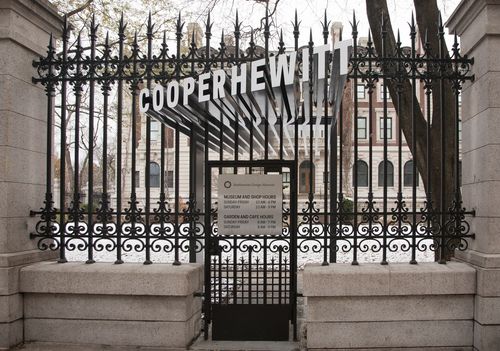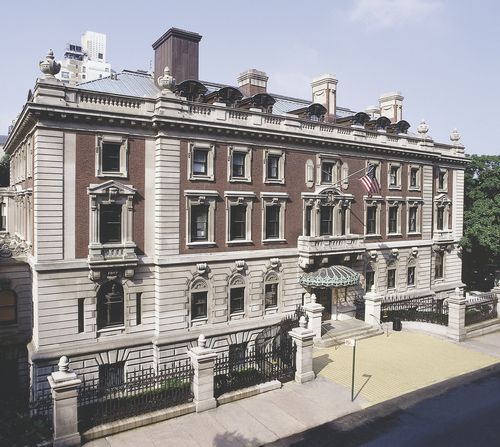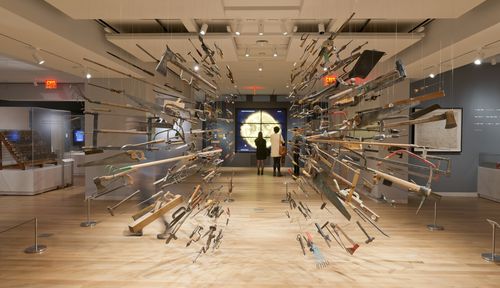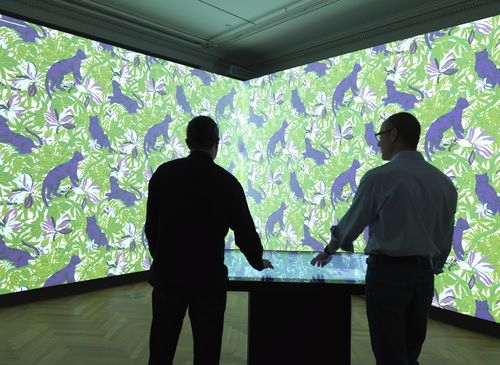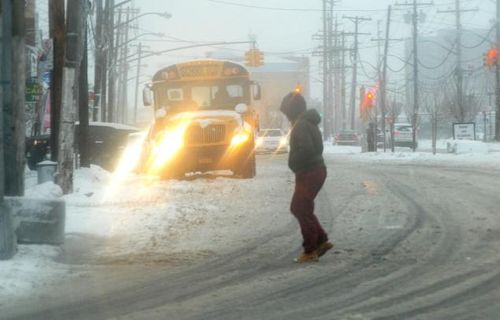CITY JOURNAL
Winter 2015
The Code of the City
by James Panero
The New York Genome Center’s project to map Gotham’s diverse genetics
Ever since James Watson, Francis Crick, and their colleagues discovered the double-helix molecular structure of DNA in 1953, scientists have dreamed of unlocking the secrets of our genetic code. Tightly folded strings of just four molecular letters, DNA contains the equivalent of a gigabyte and a half’s worth of data about our identities, ancestry, and the illnesses to which we might be prone. As Peter W. Huber explains in The Cure in the Code, understanding and harnessing the data in our genetic fingerprint “will eclipse everything that the information age has delivered so far.”
No one knows when that will happen, but geneticist Nathan Pearson thinks that he knows where the breakthrough will come—at the New York Genome Center in downtown Manhattan, which is attracting world-class geneticists to the city. A young prophet of genomic science with a soft-spoken, wide-eyed intensity, Pearson is the center’s senior director of scientific engagement and public outreach. “Here, in just a few blocks, you have this incredible diversity of humanity,” says Pearson of New York. He isn’t just referring to the broad-ranging ideas that a city can promulgate, though that helps explain why ten major medical and academic institutions came together to found the consortium behind the Genome Center in 2011. He also means genomic diversity—the variations of DNA in the city’s multiethnic population that form his source data. If the New York Genome Center had a bank of data from “a thousand Yemeni New Yorkers, a thousand Maltese New Yorkers, a thousand New Yorkers from diverse backgrounds that are still understudied in terms of genomic diversity,” Pearson says of the center’s aims, it would have a unique understanding of genetic variations in the world’s population. So when health issues with a genomic basis arise in any area of the globe, the center could check specific variants against these known ethnic differences. “We have data here that could be immediately useful,” he says.
Tapping a wide network of public-private partnerships, the Genome Center looks to advance a civic mission to improve public health while becoming a distinctive New York institution alongside the Metropolitan Museum of Art, Carnegie Hall, and the New York Public Library. “There’s this great pride of place here in institutions,” says Pearson. “There’s the sense that if you want to find the finest version of a civic institution, you will find it here. I see a chance for the Genome Center to anchor itself as a cornerstone scientific and cultural institution, where New Yorkers have a place to entrust the data in us in ways that we know will help propel health care forward.” The Genome Center hopes that, by decoding and understanding the city’s diverse genetics, it can help diagnose and cure illnesses the world over.
Until recently, New York lacked a significant biotech industry. A Center for an Urban Future study found that the city’s biotech firms employed only 563 people in 1996, compared with 22,200 industry jobs then spread among 59 public companies in the San Francisco Bay Area. Gotham’s share of the burgeoning biotech industry further declined between 1996 and 1999 because of the high cost of New York City real estate (especially in creating and zoning city buildings for laboratory work), the often adversarial relationship among the city’s health-care institutions, and Albany’s apparent lack of interest in creating an attractive climate for biotech investors.
In 1998, recognizing that New York’s biotech industry was underdeveloped, Mayor Rudolph Giuliani promoted a biotech incubator at Columbia University and created the Task Force on Biomedical Research and Development. “Since 1981, New York has fallen behind California and Massachusetts in total funding from the National Institutes of Health,” Giuliani said. “Unfortunately, the multiplicity of medical schools and health care institutions that once made New York the dominant player in medical research have frequently acted as a hindrance to growth because these institutions have traditionally competed with one another for money, talent, and prestige.”
Still, Gotham’s biotech sector continued to lag. Mayor Michael Bloomberg’s push to create a biotech center on Governors Island fell short, and the city missed out on the “genomic decade” in the years following 2003, when the first representative sequence of a human genome was published. In the 1990s and early 2000s, biotech required large, expensive machines and specialized workers, putting New York at a disadvantage compared with regions that could offer tech firms massive academic laboratories and office-park build-outs. Today, most established institutions for gene sequencing are located elsewhere: the Broad Institute of MIT and Harvard; the Wellcome Trust Sanger Institute outside Cambridge, England; and the Genome Center of Washington University in St. Louis. Each has a focus. Washington University, for example, specializes in tumors.
The hope is that New York’s late arrival to biotech will mirror its history with tech in general. While the city was not an early leader in the tech industry, it recently surpassed Boston to become the nation’s second-largest (and fastest-growing) tech center. The reasons are similar. In both computers and biotech, the early years were dominated by expensive machines and specialized workers who benefited from academic settings and office-park build-outs. Today, the cost of whole-gene sequencing has plummeted. In 1990, an estimated $3 billion was allocated for the decade-long project of sequencing the first human genome; today, the cost has fallen to just $1,500 for thoroughly reading one human sequence. With the big-data challenges of DNA partially overcome, biotech is increasingly turning to analyzing and applying genetic data to solve real-world problems. And that requires the diverse social capital that only cities can offer.
Despite the city’s slow start, the Genome Center has put down fast roots in New York. In 2010, “we were operating with a cell phone and a Hotmail account,” said Nancy Kelley, the center’s founding executive director. Kelley then brought the idea for a genome center to molecular biologists Tom Maniatis of Columbia University and Tom Kelly of Sloan Kettering. A year later, they had raised $120 million and built out an institutional consortium. By September 2013, the center was ready to open its state-of-the-art headquarters at 101 Sixth Avenue, just north of Canal Street. The building was already zoned for a wet laboratory along with office space—the Service Employees International Union had previously used it as a clinic—meaning that research could start right away. “Innovation seems to be in our DNA,” then-mayor Michael Bloomberg said at the ribbon-cutting. Last summer, the center hired its 100th employee. Its eventual goal is 500.
The Genome Center’s diverse consortium of partner institutions has helped it overcome the problem of the competing local health-care interests that Giuliani identified. Nancy Kelley’s successor, physician Robert Darnell, has assembled an all-star team of scientists from laboratories, hospitals, and medical colleges around the tristate area. Much of the center’s funding has come from individuals and private foundations, as well as through support from its member institutions. In April 2014, Governor Andrew Cuomo announced that the state legislature had approved an additional $105 million in funding to support a partnership between SUNY Buffalo and the Genome Center to advance medical science in New York. As part of this initiative, the Genome Center will receive $55.75 million from the state and has committed to match it dollar for dollar with funds raised separately.
The New York Genome Center’s offices are divided among four mid-rise floors. One level is dedicated to laboratory space, with glass walls, reinforced floors, and positive air pressure—that is, to prevent outside air and contaminants from leaking in—pumped through the rooms. One way the center hopes to fulfill its civic mission is through urgent diagnostic sequencing—the use of genomic analysis to diagnose sick patients by examining, say, the irregular DNA from someone’s tumorous tissue to optimize treatment. Currently, says Pearson, “if a child has a really puzzling syndrome, the family may spend years and thousands of dollars . . . to try to figure out what’s wrong. People call that a ‘diagnostic odyssey.’ Full genome sequencing can help some people get an answer faster and cheaper.” Eventually, the center plans to make available its entire facility for this use while also supporting prognostic screenings: “In the long run, the dream is that everybody will have lifelong, birth-to-old-age prognostics, managing their health at every stage from pediatrics to geriatrics. ‘Should I get braces’ will eventually be partly a genomic question.” Laboratory rooms are already built out and set aside; the center now awaits regulatory approval to begin this work.
Next door to these rooms, sequestered behind glass walls, are the center’s active sequencing laboratories, where the genomic research database is being built. Here the process of reading DNA and RNA is getting faster, cheaper, and more efficient. The research now typically begins with a blind blood sample provided by one of the partner institutions. In building its database, the center acquires both healthy and sick samples from the population, as well as ancient DNA and DNA sequences from the full spectrum of life—including, when I visited, from African starlings, courtesy of the American Museum of Natural History. Another focus is “microbiomes”—the bacteria in the gut, on the skin, or in the eye.
When observed through the glass walls of the Genome Center’s laboratory, the process of reading our genetic code can seem almost routine. First, white blood cells, which contain the DNA, are separated from red blood cells in a centrifuge. Chemicals then cause these cells to burst open, spilling the DNA. Filters remove other materials so that only a solution of DNA and water remains. The strands are then chopped into short pieces and copied. Dyes are added to distinguish the chemicals in the sequence, and the samples are fed into a bank of machines, which read the chunks in 100-letter snippets. The countertop machines that conduct these readings are among the most sophisticated in the world. The Illumina HiSeq X retails for $1 million and is sold only in groups of ten. Finally, a computer takes the samples, compares them with others, and assembles the snippets back into a full genetic picture. The whole process takes a few weeks. Now that all the machines are up and running, the center is able to analyze 50 genomes a day.
But the readings are just the beginning. Directly above, in an open-floor plan with standing desks, collaborative work spaces, and the latest in office ergonomics, are the programmers, doctors, physicists, and mathematicians working to make sense of the biology that the machines pick up downstairs. The open, contemporary feel of this part of the office is deliberate and necessary, says Pearson—to compete for the country’s best talent, who might otherwise choose to work in financial services, big pharma, or the latest tech start-up. The center relies on mathematicians, computer scientists, and physicists to partner with the doctors and biologists in developing algorithms to sort the data out, while much of the data storage and processing occurs in computer centers off-site. The center sits over a data pipe that leads directly to its offsite data-storage and processing facilities.
Among its current clinical trials and projects, the center’s scientists are researching glioblastoma (GBM), a brain tumor for which the median survival rate is a mere 14 months. Harnessing the computing power of IBM’s Watson, the center has partnered with 27 doctors and scientists in hopes of improving patients’ chances through a better understanding of the genomic basis of the illness. In addition, the center’s autoimmune disease project is investigating why rheumatoid arthritis flares up in patients with debilitating autoimmune diseases, by sequencing RNA before, during, and after a symptomatic episode. The Sohn Conference Foundation has approved a two-year grant to study the causes of pediatric neuroblastoma and leukemia; the center will act as the grant coordinator among partner institutions. The center has also won a federal grant that would help it develop infrastructure to become a data hub—safely storing and communicating the genetic information of 6 million patients.
While New York City and State have encouraged the center’s growth, current health-care regulations remain a hindrance to genomic innovation. Today’s standards still largely rely on population-wide studies that ignore an individual’s data. “A drug might not work on the population scale,” says Pearson. “But it can actually work for a subset of people” with the right genomic makeup.
Restricted access to genomic information and privacy laws that “lock down” patient information are additional obstacles in New York. “It’s much easier for you, as a citizen, to see your genomic data in other states than it is here,” says Pearson. “It’s your data. It’s in you and belongs to nobody else on the planet. But the state has been paternalistically concerned about what you might do with it.” Studies show that anxiety levels decline in patients who become aware of their genomic predispositions. Nevertheless, “right now, it would be very hard for you to get sequenced in New York State, and get your sequenced data back,” Pearson says.
Zoning regulations and the city’s tight real-estate economy also inhibit biotech’s urban growth potential. The Genome Center would not have been able to get off the ground as quickly as it did if 101 Sixth Avenue had not been zoned for laboratory use. Unlike the broader tech industry—which needed only ample broadband to move into the loft buildings around Union Square and Madison Square Park—biotech needs lab space and room to grow. If the city wants biotech to flourish, it must fast-track zoning and regulatory approvals and create incentives for landlords to convert real estate for laboratory use. Without such policy changes, the center, and the city’s biotech industry in general, will have a harder time fulfilling the mission “to make people’s genomes a more useful part of life in New York.”
In the Genome Center’s “innovation lab,” a smartphone-size device, plugged into a computer’s USB port, can read DNA at the flick of a switch and without expensive dyes. While less accurate than the million-dollar machines and currently unable to sequence whole human genomes, such handheld devices will soon retail in the several-thousand-dollar range and could expand the public-health potential of genomic research by inexpensively testing, for example, the genomic indicators in our air quality. “You could have sensors like this that are helping maintain public health in restaurants, potentially avoiding contamination,” says Pearson. One day soon, we may even use devices that check our bedroom dandruff each morning for the first signs of cancer, or that can monitor air quality for infectious diseases, including Ebola. “We have thought of trying to develop quick ways of sequencing microbes like Ebola on site in West Africa,” says Pearson. “Or in the air in a plane that might have trace amounts of Ebola. We haven’t done anything yet, but we have been thinking about it and talking with authorities.”
So what does genomic science mean for the future of medicine? “I’m speaking personally right now,” Pearson says. “I really can’t speak for the center because views vary a lot about this, even in our field. But doctors will have to adjust, and the staff within our health-care system will have to adjust, to patients who are more informed and empowered about their own care.” If Pearson is right, the New York Genome Center will be a big reason why.
